
The 25th of February 2003 we started our Cave 1 class in the Gainesville/High Springs area of Florida, with GUE Cave Training Director David Rhea.
The first day of the 6 day course was spent going through the fundamentals of DIR at the Blue Grotto.
As of June 1st 2003 DIR Fundamentals will be a requirement for taking both Tech & Cave classes. Until then, David runs all his Cave 1 courses as 6 day courses instead of 5 - spending the extra day for getting up to speed on the fundamentals.
We started the day going through our gear, making adjustments as we went along. Even though we were pretty squared away, there were plenty of small adjustments to be made. On each part of the rig David explained the reason and role of that piece. Think you know all there is to know about DIR equipment? Think again. When a GUE instructor explains the finer details, the concept of a holistic system really starts to sink in.
Once we were done with the equipment, we went through a couple of valve drills. Although very similar to what I had been taught during my Tech 1, there were a few small changes. Most notably the inclusion of emergency signalig while shutting down valves, and clipping off the long-hose regulator after switching to the backup (the latter was left as an open point during my T1, you could clip it off or leave it). As David kept repeating throughout the course: "What you practice on land will be what you do underwater", meaning that the details are just as important when practicing as they are when performing underwater.
Before getting into the water we also did a few line drills. For me working with the line was a skill I knew I had to get a lot better at to pass the course. I really dreaded the moment David would hand me the reel on a proper Cave dive. Anyway, David walked us through the tie-offs, running the line, where to do placements, line etiquette and so on, we did a couple of dry-runs, and then it was off to the water.
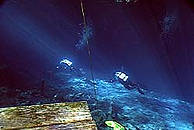 | 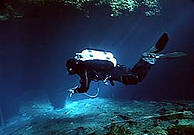 | 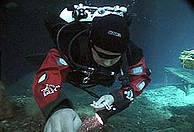 | ||
The Blue Grotto is a nice place to practice. The basin is fairly large, starts out shallow and then drops off into the cavern zone. There is plenty of space to do the drills, and when doing the line exercises there is room for a proper length course with plenty of depth variation.
We started out doing the pre-dive checks: Equipment matching, flow-check (including bubble check), safety drill and gas planning.
The drills were pretty much what we had expected: Different fin kicks (frog kicks, modified frog kicks, flutter kicks, modified flutter), helicopter turns, backwards kick and no mask swim following the line. Apart from the fact that my trim sucked, my backwards kick lacked the backward part, and my pathetic grip on the line when doing the no mask scenario, it went pretty well.
Next on the schedule was our first, and only, cavern dive of the course. David made it clear that from this point it would be all cave diving.
We started at the far end of the basin to give some distance to the run. Important things to remember during the dive was to run the reel properly, keep appropriate spacing, and of course good team communication throughout. GUE standards call for conservatism for new cave divers, so 1/6th was established as the turn pressure rather than 1/3rds which are commonly associated with cave diving.
The dive went reasonably well, no big challenges from the Cave creature on this dive, seemed like he was content with merely watching. Little did we know how much this would change later in the course. Later on when watching the video from the dive it became pretty obvious that we still had quite a bit of stuff to work on before the course was over.
After the dive we headed towards David's Riverhouse where we would be spending the rest of the week.
The riverhouse is a great enviroment for a cave course. Located next to the Suwanne river in Branford, and fairly close to Peacock, Ginne & Little River. Unfortunatly for us, Little River was closed during our stay, but we still got to enjoy both Peacock Springs & Ginnie Springs.
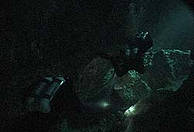 | 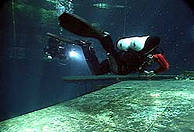 | 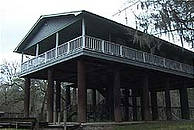 | ||
Our first day of real cave diving was spent at Peacock Springs. We would be using the Peacock I entrance, which has two runs, Pothole & Peanut.
After getting the drills out of the way, we did our gas planning & started our first cave dive. Marius was running the reel, and David showed us where to do the tie-offs. After dropping down the rather narrow crack into the Pothole tunnel we tied into the mainline just past the grim-reaper sign.
David wanted us to remember time & depth as we passed several landmarks in the cave. Easy as it sounds, you have plenty of other things to keep track of. Team awareness, communication, spacing, gas, the ever-present Cave creature and so on. More than once I realized I'd just passed the point I was supposed to check my time & depth at. Doh!
As soon as we hit our turn-point the Cave creature appeared. We never actually saw the creature itself, but the fact that our primary lights failed in quick succession spoke volumes.
We spent the remainder of the day doing a short dive on the Peanut side (Sigurd ran the reel on this one), followed by lunch and surface line-drills. On our final dive I would be running the reel on our second dive on the Pothole side. This time we would do our first gap, crossing the exit to Pothole Sink into the Nicholson tunnel. David explained what to expect and how to do the gap. Dropping down the crack with the reel I really felt like an OW student on his first decent. Somehow I managed to tie into the mainline without getting entangled in the line, and off we went.
When I reached the gap I did my striking imitation of a question mark with fins. Even though David had explained everything I kept looking at the line, looking up & down, everywhere but where the mainline continued. Eventually I spotted the mainline, pulled out one of my spools and did the gap. Just in turn to call the dive. Hello cave creature, goodbye lights.
We returned to the riverhouse for gas-filling, lectures & another excellent dinner from Tina.
The following day it was raining heavily, so we decided to to spend the day at the riverhouse and do the rest of the lectures & surface drills.
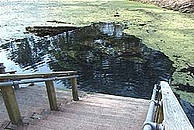 | 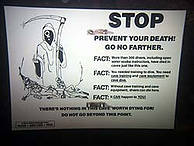 | 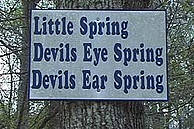 | ||
Ginnie Springs is well known among non-cavers compared to other places like Peacock. Why is pretty obvious; it has a nice recreational area, the river is great for canoeing, snorkling & swimming is also excellent. More importantly, it is home to the famous Devils Cave system, with two entrances located close together: Devils Eye & Devils Ear. Be warned, this is a very different experience than Peacock Springs.
We started out by doing the 300 yards swim, which was a breeze. I was the slowest one due to my lousy technique, but had plenty of time left. The breath-hold swim was next, and both Sigurd & Marius did it on the first try. I decided to do my best impression of an underwater lawnmover, swiming through the thick grass instead of above it. Slick move, Bubba! On the second try it went much better, and we were ready for the main event: Cave diving.
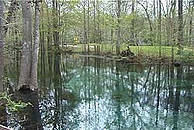 | 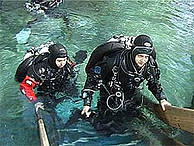 | 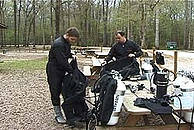 | ||
...and then cry for help as I'm swept away.
What really makes Devils different from Peacock is the flow; Where the parts we visited in Peacock had no noticable flow, Devils has plenty. If you don't use the proper technique, you will wear yourself out in a matter of minutes. David told us that the flow would probably be lower than usual due to the rain. Ya right!
We entered through Devils Ear, and due to the river intrusion caused by the rain the visibility was very low the first 20 feet. After that it cleared up. I thought the vis was great, but David would complain after the dive that it hadn't been what it used to be for the last year or so.
David was running the reel on our first dive, Marius was 1st once we hit the mainline, Sigurd was 2nd and I was crusing in the sweet 3rd spot. Nothing to do but enjoy the ride.
David had instructed us well on how to proceed. Once tied into the mainline we were to stay high in the tunnel where the flow was weaker, using pull & glide to travel through the cave instead of kicking against the flow. For the exit, we would just glide, using our fins as rudders to adjust. It went pretty well, I felt relaxed throughout the dive and really enjoyed it. This is what cave diving is all about!
We passed through the lips, a pretty narrow passage, and just reached the keyhole whan it was time to call the dive. It came as no surprise that my light failed just as we turned. Marius lost his light a second later. Sigurd & Marius switched positions and we started our exit. It didn't take long for Sigurds light to fail as well, but when he reached back for his backup-light he was in for a surprise; Both Scouts were missing. Me & Marius had noticed that Sigurds light had failed and had already turned to face him. We quickly caught up with what was going on, and Marius gave him one of his scouts for the exit. When diving DIR, all equipment is team equipment. After picking up the reel from the main-line, we made sure to empty our wings before starting the ascent. I had a little air in my suit, but that was enought to really feel the power of the flow. Bottom line: If you're not careful, you're in for a ride.
We did several dives in Devils, taking turns running the reel. One event of note was when David gave me my first gas-leak situation. I swear he was pressing his reg against my ear because the sound was so loud I'm sure I jumped a solid 3 foot. I started signaling Sigurd while I was shutting down my right post. 2 seconds later I was out of air - in the heat of the moment I hadn't switched to my backup reg. Doh! Just when I felt I was getting a hang on this cave-diving thing. I finally figured it out and switched to my backup. I'm sure I heard the cave creature laugh his ass of as we exited the cave.
We did plenty of drills both before lunch and after the last dive, practicing valve-drills, helicopter turns and backwards kick. We also got to try our hands at the unconcious diver at the bottom drill before we called it a day.
We spent the evening doing the exam, which was thorough. After the excellent lectures & pre-study however, we had no problems passing it with solid scores.
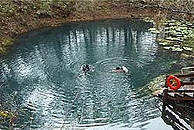 | 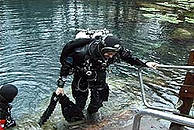 | 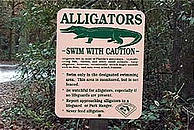 | ||
Our first two dives for the day were to be done at Orange Grove. Also located in Peacock Springs State Park, Orange Grove is the very first spring you meet on your way into the park. Compared to Peacock I, the Orange Grove basin is huge and has excellent visibility. The cave has fairly small passages though, and a thick layer of mud. Using appropriate propulsion-techniques is vital in order to to avoid stirring up the mud.
On the first dive I was running the reel. As per usual the first time in a new cave, David showed me where he wanted me to do the tie-offs. For the first time, I didn't feel like a complete ass when running the reel. After tieing into the main-line, David quickly pointed out the importance of carefully position the reel itself; If left on the ground it would stir up mud each time anyone touched the mainline.
Orange Grove is a nice cave. The small passages and constant twists & turns makes it a real fun dive, there is always a "next corner" close by. On the way out we ran into the usual problems, but at this point we were getting the hang of it and they barely slowed us down. Of course, all that changed when we reached our reel: Marius was missing (due to the order things had failed in, I was leading the dive on the way out).
Sigurd was leading the search. We covered our lights to look for the glow from Marius light. Then we scanned the passage thorougly to make sure he wasn't there, before checking our gas and figuring out how long we should search. We started swimming back into the cave, all the time looking around for any trace of Marius. After travelling a little distance into the cave, David signaled us and asked us to exit. We obviously had gone past Marius already, and started searching towards the exit again.
When we reached the spot where I could see our reel, we still hadn't found Marius. I signaled Sigurd to hold while I swam towards what looked like a small side passage. Sigurd signaled me to use a spool, and I pulled it out. Before I could do anything though, David signaled us and told us both to hold. Then he pulled Marius out of his magic hat, and we exited the cave.
What we had done wrong during the buddy search was to not stop regularly and cover our lights. We did the inital covering of our lights, scanned the passage, checked our gas, but after that we just searched with our lights. Had we covered our lights, we would have seen the faint glow from his light. I also learned that what had looked like a passage was just a dead-end, no more than 3 feet long.
We did one more dive, and this dive was the only dive our primary lights survived! Hooray! David had decided to check out our propulsion techniques to find out what had caused some minor-silting during the previous dive. Turns out our kicks were good, but when going down the small hills I stayed too horisontal, and my fins got to close to the muddy bottom. Lesson learned. Another thing which we all had noticed during the first dive was that when reaching for the SPG or switching the light from hand to hand it was easy to disturb the bottom. Likewise, when gently pushing the line down in the low passages it often disturbed silt in front of or behind of us, so it should be avoided.
..an alligator? Why yes, of course!
Our two next dives were at the Peacock I entrance. Mark, a friend of David, joined us for these two dives. For the first time during our trip we actually saw the fabled alligator that stayed at Peacock. Kinda small actually, but still fun. We decided early on to not disturb him, and hoped he would return the favour.
After the nice big basin of Orange Grove, doing the drills in the small Peacock basin was far from smooth. Our first dive would be towards Pothole Sink, and Marius was running the reel. This time the gap went much more smoothly, and we made nice progress. At around 800ft we turned the dive, and got the usual treatment from the cave creature. At one point Sigurds right post failed. He switched to his backup, and I went over to inspect. I made sure the post was closed (which it wasn't) and gave him an OK sign to check if he was ok. We then put Sigurd in the middle and continued out. During the briefing David told me I had just killed Sigurd. Oops! What happend was this: David had Sigurds right post failed. Sigurd shut it off, and David immediatly re-opened it (as he had told us he would). Then I turned it off again, and gave Sigurd an OK-sign, effetively telling him that his right post was OK. Luckily Sigurd interpreted the sign as a question and didn't switch back to the non-working reg. Another lesson learned.
Our second dive was into the Pothole tunnel, and we reached about 500ft before turning the dive. As usual, the exit was... interesting.
During the debriefing, David asked us where we wanted to go for the last day of the course. We pondered it for a while, before deciding to return to Peacock. We still felt we hadn't seen that much of the Peanut side. David was happy with the choice, and we returned to the riverhouse for a rather relaxing evening with diving-videos and cave talk.
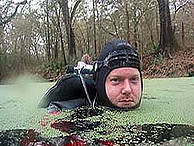 | 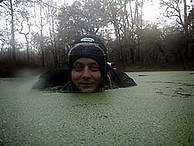 | 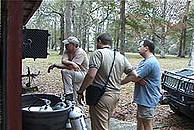 | ||
The last day of the course had finally arrived, and after an intense week we were getting pretty tired (as you can see in the pictures...).
David told us he wanted to see our very best on the last few dives, so we set out like men with a mission. Our drills seemed to go smoother than usual, even in the cramped basin. I was running the reel, with Marius 2nd and Sigurd in 3rd. The tie-offs went smooth, and off we went.
Determined to see more of the cave on this dive, we keet the pace nice and steady, focusing on trying to be as efficent as possible. After travelling through the small, shallow tunnel the cave suddenly opens up, and drops from 15 feet to around 50 feet in a big room called the breakdown-room. Beautiful! We reach a set of jump-markers at around 750ft, but still have gas to go. Just as we start heading up a slope we reach the 1000ft marker, and it's time to call the dive. After another eventful exit, we debriefied and did our final course-dive where we all got to do the lost line drill.
Back at the riverhouse, David pulled out the beers and it was official: We had passed! Hooray!
We filled & analysed our doubles before heading back to David & Tinas place in Gainesville where we would be spending the night. For our last evening together, we went to Fridays for dinner. Mark joined up with us, and we had a nice time talking about the course, caves, and diving in general.
It had definitly been an intense week. With each dive a valuable lesson was taught. With each skill mastered a new challenge or level of mastery was presented. I am convinced that no matter what level of experience you have before taking a Cave 1 class with David Rhea, you will learn more than you thought possible. And at the end, you will be a safer, better & more aware diver. In retrospect, I can't imagine how we could find the time to do everything had we not chosen to stay at the Riverhouse. It really frees up a lot of time. And who could go for such an intense week without Tinas world-famous dinners & deserts. Do yourself a favour and go for the Riverhouse lodging & the meal-deal if taking a course with David.
So, what's next? Cave 2 of course! So David watch out, we will be back.
By Lars Barstad and David Rhea (photos).